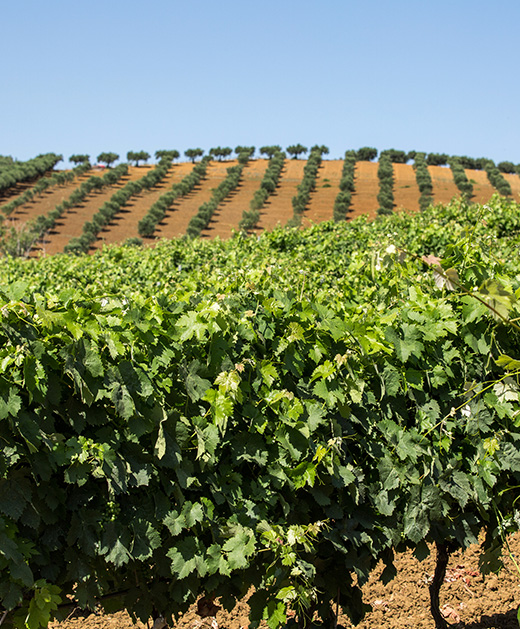
Four native vines (Catarratto, Inzolia, Perricone, Nero d'Avola) and one international (Syrah). The decision to focus on these five varietals has increased the productive specialization of the Monreale DOC area.
The five vines of choice grown in the Monreale DOC: two native whites, such as Catarratto and Inzolia, three reds, Perricone, Nero d’Avola and Syrah. The choice to focus on these five varietals reflects the partners’ wish to focus on local vines of great tradition and experiment with those who have found their natural habitat among the hills and mountains embracing the Jato Valley.
Four native vines (Catarratto, Inzolia, Perricone, Nero d'Avola) and one international (Syrah). The decision to focus on these five varietals has increased the productive specialization of the Monreale DOC area.

The five vines of choice grown in the Monreale DOC: two native whites, such as Catarratto and Inzolia, three reds, Perricone, Nero d’Avola and Syrah. The choice to focus on these five varietals reflects the partners’ wish to focus on local vines of great tradition and experiment with those who have found their natural habitat among the hills and mountains embracing the Jato Valley.
Catarratto
Catarratto, in the two versions ‘bianco comune’ and ‘extra lucido’, is Sicily’s most widely grown grape and the one with the deepest roots in the agricultural history of the island. Catarratto clusters are medium-sized (18 centimetres long on average), thick, with one or two wings and generally sparse or moderately compact. The grape is medium-sized, spheroid or ellipsoid, regular, with a circular cross section; the skin is golden-yellow and evenly pigmented, pruinose and thick, the flesh is juicy. Catarratto is sweet tasting, the yields abundant and consistent. When the grapes reach optimal ripeness – usually towards the end of August / early September – their sugar content is medium / high with a good acidity. They are hardy and resistant to pests, strong heat and drought.


Inzolia
Sicily’s most ancient white grape variety, Inzolia is now grown in other parts of Italy as well. Its origin is inextricably intertwined with the ancient Greek colonization and recent studies have attested its close kinship with varietals such as Rhoditis and Sideritis. Other sources trace its history back to the time of the Norman domination of Sicily. For a long time this varietal has mostly been used in the making of wine blends but producers have recently tried their hand at monovarietal vinification with extraordinary results: simple and immediate wines as well as more intense and structured ones. Inzolia clusters are of medium length (18-24 centimetres), large, green-yellow in colour with reddish streaks. The grapes are regular in shape with pruinose skins and a crunchy and evenly pigmented golden-yellow or amber flesh. When they reach optimal ripeness – usually around the beginning / middle of September – their sugar content is moderate and acidity is typically low.
Inzolia
Sicily’s most ancient white grape variety, Inzolia is now grown in other parts of Italy as well. Its origin is inextricably intertwined with the ancient Greek colonization and recent studies have attested its close kinship with varietals such as Rhoditis and Sideritis. Other sources trace its history back to the time of the Norman domination of Sicily. For a long time this varietal has mostly been used in the making of wine blends but producers have recently tried their hand at monovarietal vinification with extraordinary results: simple and immediate wines as well as more intense and structured ones. Inzolia clusters are of medium length (18-24 centimetres), large, green-yellow in colour with reddish streaks. The grapes are regular in shape with pruinose skins and a crunchy and evenly pigmented golden-yellow or amber flesh. When they reach optimal ripeness – usually around the beginning / middle of September – their sugar content is moderate and acidity is typically low.

Perricone
Also called Pignatello (in the province of Trapani) or Guarnaccia nera (in the province of Agrigento), Perricone clusters are of medium length (20 centimetres), large, short, of a mainly light green colour which turns vinous red towards the free end. The grape is medium-sized, rather thin and cylindrical. When ripe – usually around the second or third decade of September – it offers an ideal sugar content and good acidity. Yields are consistent and the fruit resists well to common pests.

Syrah
The only international varietal included in the DOC Monreale, Syrah has found here its ideal terroir. The clusters are medium-sized (ranging in length between 15 and 20 centimetres), with a semi-loose, elongated, basically cylindrical, irregular and sometimes winged appearance. The bunch stem is visible and quite woody. The grapes are medium-small (with a transverse diameter of 10-12 millimetres), with a regular oval shape. The skin is rather tender, pruinose and blue in colour. The colourless pulp is juicy and quite sweet. When it ripens, usually towards the end of September, it reaches a medium-high sugar content and good acidity. Yields are abundant.
Syrah
The only international varietal included in the DOC Monreale, Syrah has found here its ideal terroir. The clusters are medium-sized (ranging in length between 15 and 20 centimetres), with a semi-loose, elongated, basically cylindrical, irregular and sometimes winged appearance. The bunch stem is visible and quite woody. The grapes are medium-small (with a transverse diameter of 10-12 millimetres), with a regular oval shape. The skin is rather tender, pruinose and blue in colour. The colourless pulp is juicy and quite sweet. When it ripens, usually towards the end of September, it reaches a medium-high sugar content and good acidity. Yields are abundant.

Nero d’Avola
The prince of Sicilian vines has found an ideal habitat in the Monreale DOC area, where it is vinified both alone and in blends. The colour is ruby red, the nose offers aromas of Mediterranean maquis, earth and red berries, the palate is full-bodied, dry and elegant. The grapes come in medium-sized clusters with a visible, thick and semi woody bunch stem. The fruit is regular in shape while the skin, bluish, is pruinose, of normal thickness and leathery. The pulp is juicy and colourless. When ripe, usually between the first and second decade of September, their sugar content is excellent. Nero d’Avola can usually withstand pests and harsh weather, the yields are plentiful and consistent. It used to be also known as Calabrese but since the early 1900s it has been widely known as Nero d’Avola.





